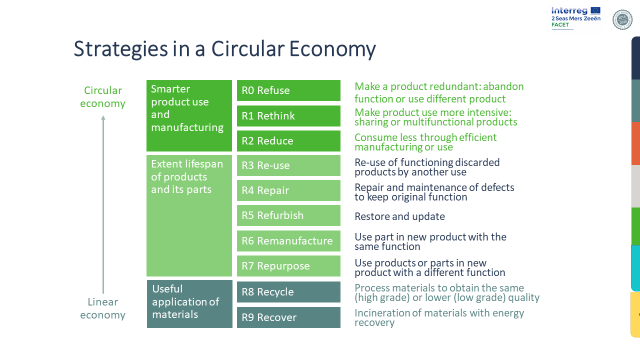Geen bewerkingssamenvatting |
Geen bewerkingssamenvatting |
||
| Regel 1: | Regel 1: | ||
=== Implementing CE-solutions: the 9R-strategies === | |||
Ideally, all materials stay within the economic production and consumption system. This ''ultimate circularity'', in which a product chain is closed because the materials can be applied over and over again, while retaining their original quality. If these can be applied in a similar product while no additional natural resources are necessary, then waste is a concept of the past. However, this is very hard to achieve in reality and full circularity is therefore the highest level, or objective within a Circular Economy. | |||
There exists a hierarchy of circularity strategies, different levels to reduce the consumption of natural resources and materials, and minimize the production of waste<sup>[1]</sup>. They can be ordered for priority according to their levels of circularity (Figure 1). | |||
More information and examples with regards to these 9R-strategies can be found here [link to 9R-strategies ppt on FACET wiki]. Within the FACET-project these circularity strategies are linked to the concept of value chains to make them more tangible.<gallery> | |||
<iframe src="https://www.slideshare.net/slideshow/embed_code/key/ljiY1xxleSzGWp" width="427" height="356" frameborder="0" marginwidth="0" marginheight="0" scrolling="no" style="border:1px solid #CCC; border-width:1px; margin-bottom:5px; max-width: 100%;" allowfullscreen> </iframe> <div style="margin-bottom:5px"> <strong> <a href="https://www.slideshare.net/secret/ljiY1xxleSzGWp" title="9R-strategies for CE explained" target="_blank">9R-strategies for CE explained</a> </strong> from <strong><a href="https://www.slideshare.net/Rinkweijs" target="_blank">Rinkweijs</a></strong> </div> | |||
</gallery> | |||
==== References ==== | ==== References ==== | ||
[1] Figure: Potting, José, et al. Circular economy: measuring innovation in the product chain. No. 2544. PBL Publishers, 2017. | [1] Figure: Potting, José, et al. Circular economy: measuring innovation in the product chain. No. 2544. PBL Publishers, 2017. | ||
{{Project FACET Tool config}} | {{Project FACET Tool config}} | ||
{{Project | {{Project | ||
Versie van 24 mrt 2021 11:50
Implementing CE-solutions: the 9R-strategies
Ideally, all materials stay within the economic production and consumption system. This ultimate circularity, in which a product chain is closed because the materials can be applied over and over again, while retaining their original quality. If these can be applied in a similar product while no additional natural resources are necessary, then waste is a concept of the past. However, this is very hard to achieve in reality and full circularity is therefore the highest level, or objective within a Circular Economy.
There exists a hierarchy of circularity strategies, different levels to reduce the consumption of natural resources and materials, and minimize the production of waste[1]. They can be ordered for priority according to their levels of circularity (Figure 1).
More information and examples with regards to these 9R-strategies can be found here [link to 9R-strategies ppt on FACET wiki]. Within the FACET-project these circularity strategies are linked to the concept of value chains to make them more tangible.
References
[1] Figure: Potting, José, et al. Circular economy: measuring innovation in the product chain. No. 2544. PBL Publishers, 2017.

